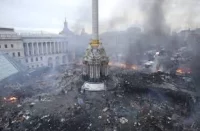Yuliya CHMELENKO (Russia)
We very often take in information without thinking about where it comes from or why it was produced. Unfortunately, that is the way things stand today with news of events in the Middle East—some things we hear about in distorted form, and some things we do not hear about at all. A lot of questions surround the story of the National Museum of Baghdad and the treasures of ancient Mesopotamian civilizations stored in it. At first glance, the situation seems very clear—looters ransacked the museum, which had been left undefended, destroying and selling a large number of artifacts. It was all very simple and apparently there was no question about what happened. But why is it that we so often hear about events that call into question the official reports that the news media are so insistent on giving us and that sometimes completely contradict the official story? What actually happened to the museum’s exhibits? Is it possible that instead of the truth they are trying to feed us a new “tale of the old orient?” In order to make sense of what happened we need to start by looking at the facts.
The Baghdad Museum was founded in 1923 in King Faisal’s Palace at the urging of the English archaeologist Gertrude Bell. The collection was moved in 1926 to a separate building and was called the Museum of Iraq. That was when it started admitting visitors. By 1966, numerous archaeological digs in Mesopotamia had significantly expanded its collection, and the museum moved into a new building that could accommodate it. Unique gold artifacts from the Treasure of Nimrod were added to the collection in 1988. Ten days after Iraq invaded Kuwait in 1990, Saddam Hussein ordered the Nimrod gold hidden in safes at the National Bank. The condition of the National Museum’s collection has been unclear since that date. The museum was closed in the spring of 1991 because military operations began, and it only opened for visitors nine years later on April 28, 2000, the 63rd birthday of the Iraqi leader. However, none of the Nimrod artifacts were among the exhibits in the national collection—they were not found until Matthew Bogdanos’s investigation in June 2003.
Disaster struck between the 8th and 12th of April, 2003, when fighting broke out on the museum grounds, and museum employees left the building. The museum was massively looted and artifacts of world culture destroyed. Thousands of priceless historic and archaeological relics belonging to the ancient Sumerian civilization and other periods of Mesopotamian history disappeared from storerooms. According to official reports, looters plundered the museum for about 48 hours. Months were required to assess the damage to the museum. Initially, 170 thousand out of the just over 500 thousand exhibits in the museum were reported lost. However, that number has since reduced many times. It is currently believed that approximately 15 thousand items were lost. Among the stolen artifacts that have been recovered were exhibits of world significance—the alabaster Uruk vase depicting the goddess Inanna (3200 B.C.E.) and the marble mask known as the Sumerian Mona Lisa or the Lady of Warka.
It was only in February 2009, six years after the invasion, that the museum was again able to open its doors to visitors, primarily by using funds from outside the country. Financial assistance provided by Italy’s government (about €1 million) was particularly helpful. However, only about 8.5 thousand of the 15 thousand lost exhibits have been recovered. Official sources have the following to say about the looting of the Iraqi museum’s cultural valuables.
The television company NBC televised a report about the devastating invasion of the National Museum of Antiquities of Iraq in Baghdad by looters. NBC said that according to witness reports the looters plundered exhibits, burned documents and inventory lists stored in the museum and got into the underground storage rooms where especially valuable artifacts were kept.
Marine Corps Reserve Colonel Matthew Bogdanos organized a large-scale investigation into what happened and a search for the missing property on April 16, 2003. His team was able to assess the scale of the events and offer amnesty to the people of Baghdad for returning cultural artifacts. That resulted in the return of almost two thousand exhibits to the museum. A large number of exhibits were also found during special raids. In addition, Bogdanos gave information about the destruction of the museum to UNESCO, museum curators and antiquarians in Europe and the United States, the coalition forces headquarters and the customs services of all Middle Eastern states. These actions led to the recovery of a large portion of the stolen exhibits—about five to six thousand items, including the gold of Nimrod that had disappeared in 1991.

Over the next five years the FBI, Interpol and customs officials in Syria and Lebanon recovered about 1.5 thousand more items and returned them to Baghdad. Iraqi Minister of Tourism and Antiquities Qahtan Abbas told AFP in an interview that items surfaced in Europe, Middle Eastern countries, Japan and Peru. However, part of the collection has found its way into private collections. According to UNESCO, three to seven thousand items are still considered missing.
Virtually all of the blame for what happened belongs to the inaction of American soldiers and the thoughtless acts of the looters. Former museum director Donny George called the failure of the Americans to intervene the “crime of the century.” Deputy Director Nabhal Amin believes that the Americans were obligated to protect the museum: “If they had just one tank and two soldiers nothing like this would have happened. I hold the American troops responsible for what happened to this museum.” Her resentment is entirely understandable; by the time the Americans finally put a guard on the museum, it was the most looted building in the Iraqi capital—28 galleries, storerooms and archives were in ruins. Mohsen Kazim, who had guarded the museum for 30 years, was outraged by the recklessness of the looters: “We know people want to eat, but what will they do with these ancient artifacts?”
However, statements by eyewitnesses that are mentioned less frequently in the news media provoke interest and raise questions. In trying to understand what went on, we are often faced with the fact that the museum staff believe the looters knew what they were looking for and acted intentionally, destroying and carrying off only the most valuable exhibits. The robbery was carried out by a well-prepared group of people completely unopposed by American soldiers. Of course, there were also thieves who acted spontaneously. Some sources claim that the Americans almost seemed to guard the looters. These surprisingly well-prepared criminals easily opened the steel doors of storerooms and were well acquainted with the layout of even the underground storerooms. US Attorney General John Ashcroft confirmed that in his interview: “From the evidence that has emerged, there is a strong case to be made that the looting and theft of the artifacts were perpetrated by organized criminal groups—criminals who knew precisely what they were looking for.” Officials hastened to say that the thieves were Iraqis. However, Rumsfeld took no actions to prevent the thefts or stop them, which can hardly be called a simple oversight. US scholars warned the Pentagon about the possibility of theft even before the war started and requested that it prevent the destruction of ancient artifacts. In its report on the subject broadcast Monday, NBC referenced the well-known American orientalist Maguire Gibson of the Oriental Institute of the University of Chicago. Gibson said that he visited the Pentagon three times before the beginning of US military operations in Iraq and warned American military authorities about the value of the unique collections in the Baghdad museums. Similar meetings were held in the US Department of Defense by a delegation of museum workers, scholars and collectors who also called on the Pentagon to make every possible effort to save that world heritage. However, they were unable to prevent the Baghdad museum from being looted.
The reason why officials displayed so little willingness to stop the looting can be explained by the fact that they saw their mission as reducing Iraq’s significance as a nation, and the actions by the Iraqi looters only contributed to that. According to Michigan University President Peter McPherson, who headed the Treasury Department’s Iraq team, “The privatization that occurs sort of naturally when somebody took over their state vehicle, or began to drive a truck that the state used to own, was just fine.” John Agresto saw his job in Iraq as the remaking of Iraq’s system of higher education from scratch. In that context, the looting of local universities and the education ministry was, in his words, “the opportunity for a clean start.” However, it is unlikely that he knew Iraq had the best education system in the region before it was strangled by sanctions. Iraq had the highest level of literacy in the Arab world—89% of Iraqis were literate in 1985. Unfortunately, according to local residents, many American soldiers did not even know that Iraq’s history stretches back more than seven thousand years.
But none of this explains the intentional destruction by looters of the most important antiquities. For example, they flattened the nose and beard of the copper head of the Akkadian king (about 4300 B.C.E.) and, and they destroyed hundreds of clay tablets with ancient cuneiform writing. The journalist and writer Viktor Filatov sees in these actions nothing more than a desire by Jewish nationalists to destroy all traces of a more ancient culture. As we know, virtually the entire Old Testament is largely a repetition of ancient Sumerian legends about the flood, which refutes the Jewish claims of being the progenitors of mankind’s cultural heritage. Filatov believes that the looters acted on instructions from Jewish nationalists to destroy not only artifacts, but ancient culture as such.
Apparently, the people who damaged the head of the Akkadian king were governed by blind vengeance similar to other Iraqis who were opposed to Saddam Hussein’s regime and vented their feelings on his many statues. It is difficult to say whether it was Jewish nationalists and people acting under their orders or Iraqi extremists indignant at what was happening in their country. It may have been both. Most likely, it was mainly specially trained groups who destroyed the cultural artifacts in the Iraqi museum; the number of Iraqi looters was small. All of the authors generally fall into two extremes. Either they blame Americans after Iraqi oil, or they blame Jewish nationalists who want to destroy the real “cradle of human culture.” Someone is still screaming about world terrorism. However, there are specific individuals behind all of these events—people obsessed with huge amounts of oil money or with an ideology who try to cover up and depersonalize their activities with concepts like “the Americans,” “Iraqi looters” or “Jewish nationalists.” After all, those “Americans” that most people blame so vehemently are millions of housewives and ordinary working men and women who have little understanding even of the price of oil, and American soldiers are only people carrying out the orders of their leaders—specific individuals. The word “soldier” has no nationality. We should not forget that it was the US government that funded the restoration of the museum (Washington allocated $13 million). So all of these accusations are nothing more than a cry in the wilderness. We cannot put all Americans, Iraqis and Jews on trial. It turns out that there is an enemy, and everybody knows him. He is discussed and accused, and people feel better for that. We know who the guilty party is, but who specifically is accountable for what happened? Unfortunately, only a few scapegoats snatched from the crowd of “guilty parties.”
Thanks to Google, cultural support by Italy and financial support from the US State Department, a virtual National Museum of In Iraq has been created on the Internet. It gives all Internet users access to the treasures of the Baghdad Museum, including the lost and missing exhibits. “This is not just a repository of objects stored in the museum. This is a virtual journey through the six thousand years of Mesopotamian history, intended for the general public, and for the scientific community,” said Roberto De Mattei, Director of the National Research Council of Italy. However, the virtual project can never replace the actual art objects. As Gordon Newby, a historian and Professor of Middle Eastern Studies at Emory University in Atlanta said, what happened in the museum “is just one of the most tragic things that could happen for our being able to understand the past.”
Accusations that Abdul Talakani’s ministry is not overly concerned about the fate of pre-Islamic artifacts are certainly not justified. He justifiably refutes the accusations by saying it is hard to talk about antiquities when people are dying, or when they have no lights or water, and he added that it nevertheless needs to be done before it is too late. Therefore, the main task now is to prevent museum valuables from being looted again and provide the needed level of security both for the National Museum of Baghdad and for the other no less important historical facilities in Iraq.














There so many thing that people even don’t know. USA is on the loot and plunder spree. It is avenging its failure in subjugating nations. Now US is on the height of its frustration, as its super technology is not working in, it is being condemned at home and abroad.
According to a recent poll reported by ‘Rethink Afghanistan’ 60% of American people want them back home at the give time by Obama.
In Afghanistan they are at the mercy local contractors without whose safety it is almost impossible for the NATO troops to move even for the patrolling the area.
They have hired vagabonds and notorious people who are heavily paid and do their job bribing Taliban for safe passage.
They are reported to pay certain Afghans who fire stage sabotage that is blamed on Taliban and in turn keep such thugs in jobs as these create more scare.
Such are the affair, can a war be won with such dependence, well it can be prolonged at the cost of people’s miseries.
Pingback: Cum să omori 1 milion de oameni pe tăcute: Operatiunea Ceaţa Purpurie « Lumea dupa Eufrosin
Pingback: Crimele si controlul mintii-distractia guvernelor! « Nogovernment's Blog
Pingback: Cum să omori 1 milion de oameni pe tăcute: Operaţiunea Ceaţa Purpurie | Ilfovul nostru
Pingback: Cum să omori 1 milion de oameni pe tăcute: Operaţiunea Ceaţa Purpurie | AlterMedia România (fondată 2002)
Pingback: Operaţiunea Ceaţa Purpurie « Planeta Prizonieră
In 2003, Lebanon-born Fouad Ajami, listed as an ‘Author’ in Israel Hasbara Committee – wrote in Foreign Affairs that America’s unilateral war on Iraq will bring modernization to the Middle Eastern countries and thus, security to Israel. After seven years, the reality on ground shows that he lied from both sides of his mouth – an so did Dubya Bush who proclaimed “Mission Accomplished” on board USS Abraham Lincoln on May 1, 2003. At that time, Bush also claimed that Saddam Hussein had links with Al-Qaeda and that he was behind 9/11. None of which has been proved so far.
Now, after seven year, another US President, Ben Obama, had lied by asserting that he is pulling 50,000 ‘combatant soldiers’ out of Iraq, while keeping the remaining 50,000 ‘non-combatant soldiers’ to stay put in Iraq to carry-on Fouad Ajami’s prediction – the security of Israel.
The loser in this war (like wars in Afghanistan and Lebanon) is mainly the Iraqis and the Americans. Let us count some of the losses during the last seven years of Iraqi adventure for Israel.
1. More than 6,000 American killed and over 100,000 wounded. Iraq has lost over one million people since the Washington’s wars begining in the 1990s.
2. Iraq war has already cost to taxpayers over US$745 billion and expected to reach one trillion dollars soon.
3. America has lost its credibility within the Middle East countries. This was told to Benji Netanyahu last year by both Mullen and Joe Biden. The vacuum has been filled by Iran, Turkey and Syria. Ahmadinejad, Sheikh Nasrallah and Erdogan have become the most popular Muslim leaders among the Arabs.
Israel in the meantime has attacked Lebanon, Gaza and Turkish vessels – but fears more for its survival than post-Iraq War. Now, it’s pushing Ben Obama to start new wars in Lebanon, Syria, Pakistan and Iran for Israel’s survival.
Let us not forget, the ‘Israel-First’ Jew in Pentagon, Paul Wolfowitz, who told Dubya Bush that “Iraq War will pay for itself”. John Bolton, the ‘half-Jewish’ neocon repeated the same line in 2006. According to Brain Hicks, author of ‘Profit from the Peak’ revealed in 2008 that US forces in Iraq are costing US$923 million per week on fuel consumption alone.
Lately, many of the neocons (mostly Jewish) are blaming the Islamic Republic for the Washington’s failure in Iraq. Israeli poodle,General Petraeus told ‘Israel-Firster’ Senator Joe Leiberman during a Senate testimony on April 8-9, 2008 that Iran is behind the murder of hundreds of US soldiers and NOT Israelis in Iraq.
Just imagine what it would cost American taxpayers if their leaders decide to repeat their mistakes in October 2001 and March 2003 in Islamic Iran to please the Israel Lobby.
http://rehmat1.wordpress.com/2010/09/05/washington-from-iraq-to-iran/
Pingback: Importance of The Monuments Men | Political Film Blog
Pingback: Why black Americans should invest in art pieces | theGrio
Pingback: Why black Americans should invest in art pieces | CE Marketing & Promotions
Pingback: The Evolution of Astrology | Free Sidereal Astrology
Pingback: Cum să omori 1 milion de oameni pe tăcute: Operaţiunea Ceaţa Purpurie | Lupul Dacic
Pingback: Why black Americans should invest in art pieces - theGrio